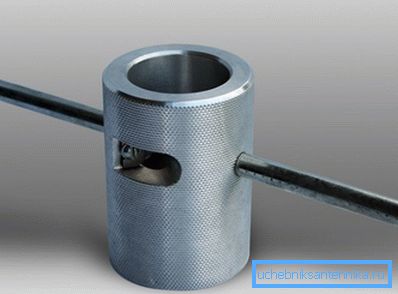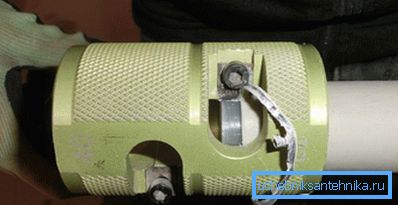How to clean the polypropylene pipe
Pipe stripping is done in order to get rid of the polymer layer and the protective coating, which is necessary for subsequent welding work. It is taken into account at the same time that the material is cut off of the thickness that is needed for the fitting nozzle.
For this you need a special device. Such devices are small, they are perfect for home use in the bathroom or toilet. There are also large ones - for processing pipelines of considerable scale, which are usually used in the construction of multi-storey buildings.
Many probably would like to know how to clean the polypropylene pipe and why is it necessary to thoroughly clean the ends of polypropylene pipes, despite the fact that they would seem rather smooth?

In order to avoid damage and undesirable consequences, a polypropylene pipe is protected.
Tip! Do not rely only on the reinforcement coating. Pipe fixing points may contain irregularities and temperatures close to 100 ° C may soften the junction of the pipeline, resulting in leakage. That is why it requires stripping the ends at the joints of pipes.
How to properly remove the reinforced layer
Polypropylene pipes can be cleaned by the following methods. If the reinforced layer is located on the inner side, remove the foil from the inner cavity.
Tip! Aluminum should not be in contact with water, which will easily enter into an electrochemical reaction with it, which will lead to the destruction of the entire reinforced layer.
If you are dealing with fiberglass that protects the polypropylene layer, stripping is not required at all, since the mesh part of the fiberglass is located on the inside of the pipeline, it will not be in contact with the fittings during smelting, and the water is not intimidating. That is why it is often preferable to choose polypropylene in a composition with fiberglass. Preparation does not take much time, installation of pipes and fastening of joints are made easily, welding of polypropylene pipes is carried out without stripping.

Scraping the outer layer. In this case, the aluminum tread layer is on the outside. This foil should be removed, due to the fact that when cooking, the joints of aluminum and plastic are extremely unreliable. With the help of special equipment, the reinforcement is removed to the depth required for fitting the fitting and connecting other parts.
Work with a tweezer
In such work, the most often used technical butler, electric drill, manual cleaning without special tools is possible. Tools for manual use have a convenient removable handle for greater comfort. During the work with a drill special nozzles which are mounted instead of the drill are used.

Stripping the outer reinforced part begins with the fact that a special coupling is placed on the end part of the material. Then the clutch should be rotated 1-2 turns, after which the output you will get a perfectly flat cut. The whole process is extremely simple and will not take more than two minutes.
The trimmer cuts off the intermediate layer, its edges are mounted from the inside. The work consists in the following: the end cutter is mounted on the tip of the pipe, a pair of turns is made, after which you can begin the welding work.
Work with electric drill
Special nozzles for electric drills make it possible to immediately remove the inner and outer layers at once. When working with a drill, attention should be paid to the number of revolutions of the device. Select the nozzle should be individually depending on the type of reinforcement.
Cleaning your own polypropylene pipes is possible in cases where you need to quickly remove the polymer layer and the reinforced part, and the desired device is not at hand. In this case, the layer is cut off with a conventional technical knife, to the same depth that is required to mount the fitting. You can perform work with the use of special tools and without them. The process itself is very simple, does not require special skills and does not take more than five minutes.
Video
This video shows the process of removing a reinforced layer of polypropylene pipes without special tools: